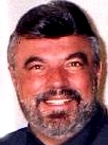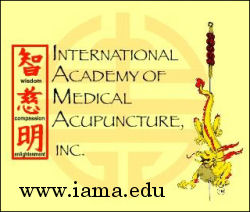Acupuncture & TCM Articles

Acupuncture Articles
by John A. Amaro L.Ac., Dipl.Ac.(NCCAOM), DC
 Dr. Amaro is an internationally known author, lecturer and practitioner beginning his practice of Acupuncture and Chiropractic in 1971. He has led 13 diplomatic Acupuncture study tours of The People's Republic of China escorting more than 500 doctors and practitioners. He has personally studied Acupuncture in nine separate Asian nations. Dr. Amaro is an internationally known author, lecturer and practitioner beginning his practice of Acupuncture and Chiropractic in 1971. He has led 13 diplomatic Acupuncture study tours of The People's Republic of China escorting more than 500 doctors and practitioners. He has personally studied Acupuncture in nine separate Asian nations.
He has received Certification in Acupuncture through the Columbia Institute of Chiropractic in 1973. This was one of the first Acupuncture postgraduate education programs for physicians in North America commencing in 1972.
He has been certified by the Waseda Acupuncture College in Tokyo, Japan in 1974 and graduated from the Chinese Medical Institute, Kowloon, China in 1976. He had previously taken postgraduate studies at the Tai Chung Medical School Taipei, China 1973.
How to interpret the clinical results
of Electro Meridian Imaging (EMI)
John A. Amaro L.Ac., Dipl.Ac.(NCCAOM), DC
Having written a column for “Acupuncture Today’ since its third issue in 2000, I have focused on a variety of topics from the treatment of pain to successful practice principles, referrals, fertility, veterinary acupuncture, political issues, Auriculotherapy, chakras, and more. With “Acupuncture Today´s’ very visible presence on the World Wide Web, my articles along with the other columnist, reach virtually every known inhabited nation on the globe. As a result, of this international presence, I personally receive e-mails from acupuncture/TCM colleagues from around the world asking me to expound on a topic or to simply ask a specific question on something I had written.
Without a doubt the number one question posed of me by acupuncturists worldwide in addition to physicians utilizing acupuncture as an adjunct to their practices is; How do you interpret the results of the Electro Meridian Imaging (EMI)?
As the acupuncture profession enters into the 21st Century, it is imperative it grow and enhances acupuncture with available technology which did not exist in acupuncture´s formative years hundreds of years ago. Even though we proudly proclaim that our healing art is 5,000 years old, living in a contemporary, modern, technologically advanced world has offered us a variety of new procedures unheard of or beyond our comprehension in years past. Electro Meridian Imaging (EMI) or contemporary acupuncture diagnosis is but one of those landmark discoveries.
The first and foremost rule in interpreting the results of “EMI´ is to simply understand the working mechanisms of “Ching Luo Mai’ or Meridian Acupuncture. With EMI we are not focused on either pulse or tongue findings but rather the electro dermal resistance and the relationship of the Yuan (Source) points as they represent the homeostasis of the meridian system.
In the proper interpretation of Electro Meridian Imaging (EMI) it is absolutely imperative one have a very thorough knowledge of the trajectory of the meridians and associated factors of the Five Elements along with the physiological interconnections of each of the 12 main meridians. In the case of the Lung meridian, it is intimately associated with the Spleen, Kidney, Heart, Large Intestine, San Jiao and Liver Meridians . Meaning a patient with a respiratory condition or severe disabling dermatologic condition (lung controls skin) may have at the root of their problem an imbalance of any of the above mentioned meridians, which would negatively effect the Lung meridian. The condition may have nothing to do with an altered EMI examination of the Lung however; any meridian in imbalance could and will trigger an energetic response in the body.
In the professional practice of acupuncture, one never wants to assume a person has an involvement of the Stomach meridian because they have gastric symptomatolgy. The problem may be coming from the Spleen, San Jiao, Gallbladder, Large Intestine, Liver, Small Intestine or Pericardium. The practitioner who is able to determine where the imbalance is stemming from “wins’.
It is imperative to know that Liver (Foot Jue Yin) controls the eyes, tendons, ligaments, involved with muscle metabolism and the fingernails, affected by the Spring of the year, affected by wind and anger. Whereas the Lung meridian controls, the thyroid, mucus, the nose, the skin, affected by dryness, the Fall of the year, and grief. Each of the 12 meridians has similar associated factors which are vital in the understanding of Meridian Acupuncture. Since this is an article specifically for acupuncture practitioners, I must assume the professionals reading these pages have an in-depth knowledge of the principles of acupuncture along with the internal and external trajectory of the meridian system. This form of acupuncture goes beyond TCM and has its main focus on the condition of the balance of the meridian system.
In essence this is the answer to the question “How do I interpret the results of the Electro Meridian Imaging’? First off conduct a proper and accurate EMI examination and secondly, treat what you find. The EMI will pick up whatever meridian resistance is out of general balance. It makes no difference in the story of the Three Little Bears, if the porridge was too hot or too cold, if the bed was too hard or too soft, the fact was it was not “right’. The same is true for EMI findings, do not try to interpret if a meridian is below the average range what that may indicate or if it is above the average what problems may be shown. If it is too high, too low or split between right and left it will affect the meridians electro magnetic flow and produce pathology within the body. This imbalance can be successfully treated by using BU (tonification), Xie (sedation) or Luo points on the involved meridian. It is more important to discover what meridians are out of proper balance and restore homeostasis than to try to associate a particular set of symptoms to a meridian which is too high, too low or split between left and right.
Perhaps the best advice is to take the EMI for what it is and do not try to read TCM findings into it. Remember those who are expert at the 28 pulse characteristics, have an entirely different interpretation of what a tight, boggy, leathery, minute pulse portrays than what an Electro Meridian Imaging practitioner may ascertain if they were to see an extremely high Pericardium, a low Gallbladder, a high Spleen and a very split Kidney.
Even though the EMI will not tell you the same thing the pulse will, it is extremely more accurate than the pulse regarding physiologic involvements of the meridian system. Those practitioners, who are expert in pulse diagnosis, find the addition of the EMI to provide another link in understanding the needs of the patient. Practitioners who feel inadequate with pulse diagnosis find the EMI to be the catalyst which enables them to understand the overall condition of the patient as long as they simply treat what they find by simply tonifying, sedating or Luo points.
Some will assume the patient may have a lumbar problem if the Bladder meridian is involved, however the Kidney, Small Intestine, Lung, Gallbladder, San Jiao, Liver, or Spleen may be the causative meridian of lumbar pain. Treat what you find.
Once a balancing treatment has been delivered following EMI evaluation by utilizing the Bu, Xie or Luo points depending on which meridians are below the average, above the average or split from left to right, it is suggested to utilize common sense acupuncture points for the condition presented. One of the most important things is to be sure to repeat the EMI examination at least every four treatments as the overall balance of the system will change with acupoint stimulation.
In a nut shell, the main rules are:
1. Conduct an Electro Meridian Imaging (EMI) evaluation on initial consultation and examination along with the tongue and pulse if that is a part of your regular exam.
2. Treat what you find by using tonification, sedation and Luo points.
3. In extremely severe involvements, adding the MU points will help considerably.
4. Do not make assumptions as to what a high, low or split meridian indicates you will only be guessing (remember the Three Little Bears).
5. In addition to EMI treatment protocols, utilize common sense acupoints and treatment approaches from your education as an acupuncture practitioner.
6. Repeat the examination a minimum of every four treatments. It is ok to conduct an EMI every visit should you wish as the Qi and energetics of the body is constantly in a state of flux with treatment.
7. Charge a legitimate fee which you feel comfortable with and are not apologizing for. I personally charge $75. for the first examination with follow up examinations at $35. Remember they only take one minute and 30 seconds to conduct. Many of my colleagues charge considerably more or considerably less depending on their individual comfort zone.
All the Best to you for an expansive practice and great personal and professional satisfaction.
|
